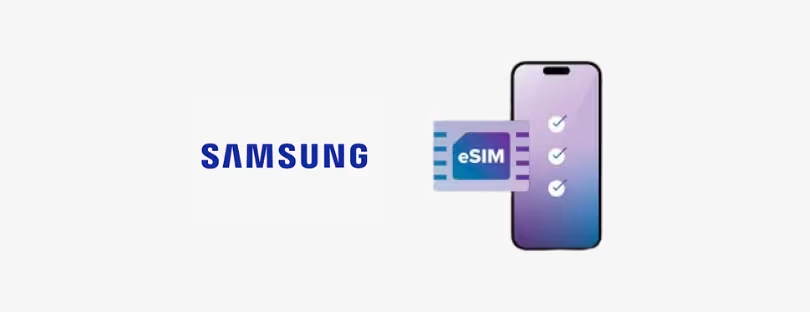
eSIM 101: Everything You Need to Know About Embedded SIM Cards
An embedded SIM card, or eSIM, is a digital SIM card that is embedded directly into a device. Unlike physical SIM cards, eSIMs cannot be removed or transferred between devices. eSIM 101
The key differences between eSIM and traditional physical SIM cards are:
Removable vs Non-Removable
Physical SIM cards are removable chips that can be taken out of a device and replaced. eSIMs cannot be removed from a device. The eSIM profile is permanently embedded in the device’s hardware.
Transferable vs Non-Transferable
Physical SIM cards can be transferred between compatible devices. You can remove a SIM card from one phone and insert it into another phone to transfer service. eSIM profiles are locked to the specific device hardware and can’t be transferred.
Physical Card vs Digital Profile
Physical SIM cards are plastic cards that store data and identity profiles. eSIMs have no physical component; they store digital SIM profiles directly in the device.
eSIM vs Physical SIM eSIM 101
An eSIM differs from a physical SIM card in a few key ways:
Size and form factor
eSIMs are embedded chips built into the device, while physical SIMs are plastic cards that need a SIM tray slot. eSIMs allow for smaller and thinner device designs without compromising on connectivity.
Ease of switching
With an eSIM, you can download and switch operator profiles over the air without having to physically insert new SIM cards. This makes it easier to change plans or operators.
Multiple profiles
eSIMs allow you to store multiple operator profiles on one chip. You can switch between profiles easily for separate numbers, data plans, etc. Physical SIMs can only store one profile at a time.
Durability
Since eSIMs have no moving parts and are embedded in the device, they are more durable than physical plastic SIM cards.
Security
eSIM profiles are stored securely with encryption on the device’s internal chips.
The main benefits of eSIM include:
Simple Activation
eSIM activation can be done remotely, without having to physically insert a SIM card. This allows for streamlined digital activation.
Multiple Profiles
eSIMs can store multiple SIM profiles digitally, so you can easily switch between profiles and even have dual SIM functionality.
Global Roaming eSIM 101
It’s easier to switch eSIM profiles when traveling internationally, enabling better global roaming support.
Less Hardware
With no physical SIM card, devices with eSIM can have sleeker industrial designs with less hardware slots and tray openings.
So in summary, an eSIM provides the same functionality as a traditional SIM card, but in an embedded digital form within the device hardware itself. The lack of a removable physical card provides both advantages and limitations compared to standard SIM cards.
How eSIM Works
eSIM stands for embedded Subscriber Identity Module. As the name implies, the eSIM is embedded in the cellular modem of a device and cannot be removed like a physical SIM card.
The eSIM contains a standardized architecture defined by the GSMA that allows it to securely store multiple operator profiles. An operator profile controls access to the mobile network and contains info like the subscriber ID, operator name, network policies, etc.
To connect to a mobile network, an activation process securely downloads an operator profile over the air to the eSIM. The profile gets installed in a hidden, secure area of the eSIM. Only one operator profile can be active at a time to connect to that carrier’s network. Switching between profiles allows you to change carriers with the same eSIM.
Profiles are managed by a Subscription Manager, which is controlled by the eSIM vendor. The Subscription Manager securely downloads, installs, switches, updates, and removes profiles on the eSIM through the network.
So in summary, the eSIM architecture stores multiple operator profiles and uses over-the-air communication with the network to securely download and manage profiles to connect to different carriers. The embedded nature allows manufacturers to solder the eSIM into devices rather than use removable physical SIM cards.
eSIM Activation eSIM 101
There are two main methods for activating an eSIM on a compatible device:
Over-the-Air (OTA) Activation
OTA activation allows you to activate your eSIM profile remotely, without having to insert a physical SIM card. Here are the steps:
1. Contact your mobile carrier to request an eSIM activation. You’ll need to provide your IMEI number so they can link your device.
2. Your carrier will send an SMS with a link to download the eSIM profile. Click the link to start the download.
3. Follow the on-screen prompts to install the eSIM profile and activate the service on your device.
4. Once activated, you can start using mobile data and make calls over the cellular network.
QR Code Activation
Some carriers also allow eSIM activation using a QR code:
1. Contact your carrier to get a QR code containing your eSIM profile. This may be provided in-store, emailed, or accessible via your online account.
2. Open the eSIM management app on your phone and scan the QR code.
3. Follow the on-screen prompts to download and install the eSIM profile.
4. Your device will activate the new cellular plan associated with the scanned QR code.
The main advantage of QR code activation is the ability to quickly set up eSIM profiles by scanning a code rather than waiting for an OTA SMS. The process only takes a few minutes.
How does activating eSIM work?
Activating eSIM is easy. First, make sure your device and carrier support eSIM. Then you can download your cellular plan directly on your phone using the carrier’s app or website. The entire process happens digitally without the need for a physical SIM card.
eSIM Compatible Devices
eSIM technology is being adopted by more and more device manufacturers. Here are some of the most popular smartphones, smartwatches, and tablets that currently support eSIM:
Smartphones
– iPhone XS, iPhone XS Max, iPhone XR, iPhone 11, iPhone 12, iPhone 13, iPhone14, iPhone 15 (All models)
– Google Pixel 3, Pixel 3 XL, Pixel 3a, Pixel 4, Pixel 4 XL, Pixel 4a, Pixel 5, Pixel 6, Pixel 6 Pro, Pixel 7, Pixel 8
– Samsung Galaxy Fold, Galaxy Z Flip, Galaxy Fold 2, Galaxy Z Fold 2, Galaxy Z Flip 3
– Motorola razr 2019, Motorola razr 5G
– LG Velvet, LG Wing
– OnePlus 8 Pro, OnePlus 8T
Smartwatches
– Apple Watch Series 3, Series 4, Series 5, Series 6, Series 7, Series 8 (Cellular models)
– Samsung Galaxy Watch, Galaxy Watch Active, and Galaxy Watch Active 2/3 (LTE models)
– LG Watch Urbane 2nd Edition LTE
Tablets
– Apple iPad Pro 11-inch (1st gen and later)
– Apple iPad Pro 12.9-inch (3rd gen and later)
– Apple iPad Air (3rd gen and later)
– Samsung Galaxy Tab S6, Galaxy Tab S7, Galaxy Tab S8 (5G models)
This list covers some of the most popular eSIM-compatible devices, but many more smartphones, watches, and tablets are being released with eSIM support. As eSIM becomes more widespread, compatibility will continue to grow. A complete list of eSIM-supported phones is here.
eSIM Carriers and Support eSIM 101
According to a recent report by the GSMA, there are now over 700 mobile operators worldwide that support eSIM. This is a significant increase from just a few years ago when eSIM was still a relatively new technology. The growth of eSIM is being driven by a number of factors, including the increasing popularity of smartphones and other devices that support eSIM, the growing demand for more flexible and convenient mobile connectivity, and the cost savings associated with eSIM.
Check out the Best eSIM Providers for 2023.
 eSIM Multiple Profiles
eSIM Multiple Profiles
One of the key benefits of eSIM is the ability to store multiple profiles on a single eSIM. This allows you to easily switch between different carriers and data plans on one device.
With a physical SIM card, you can only have one active cellular plan at a time. To switch plans, you need to obtain a new SIM card and swap it into your device.
eSIM makes switching plans as easy as selecting a different profile on your device. All your eSIM profiles are stored securely on the eSIM chip.
To switch between eSIM profiles:
On iPhone, go to Settings > Cellular > Add Cellular Plan to activate additional profiles. You can choose which eSIM profile is active.
On Android, go to Network & Internet > SIMs > Add new SIM profile. You can select the active profile.
On Windows 10 devices with eSIM support, you can add and manage profiles under Settings > Network & Internet > SIMs.
With multiple active profiles, you could use one eSIM number for personal use and another for work. While traveling abroad, you could obtain a local data eSIM profile and use both the local and regular profiles.
The eSIM standard allows for a maximum of 16 active profiles stored on the eSIM. However, the number of simultaneous active profiles depends on carrier and device support. For example, the iPhone currently only allows two active eSIM profiles.
The ability to store multiple operator profiles securely and switch between them on one device makes eSIM very convenient for consumers and travelers. It eliminates the need to obtain multiple physical SIM cards.
eSIM Security eSIM 101
eSIM offers several security advantages over traditional physical SIM cards. Some of the key security benefits of eSIM include:
Encryption
The data stored on an eSIM is encrypted. This prevents unauthorized access to the sensitive data on the eSIM if a device is lost or stolen. The encryption algorithms used are designed to be very difficult to crack, keeping the eSIM data secure.
Physical SIM cards do not have encrypted data storage by default. While the SIM card can optionally be locked with a PIN code, the data itself is unencrypted. This makes it potentially vulnerable if physical access to the SIM card is obtained.
Remote Management
eSIM profiles can be managed and updated remotely over-the-air by the mobile carrier. This allows new profiles to be added, existing ones modified, and stolen or lost profiles to be deleted without physical access to the device.
With physical SIM cards, profiles can’t be remotely provisioned. To add, modify, or disable a SIM, you need physical access to insert, replace, or remove the card. Remote profile management provides more security and convenience with eSIM.
Anti-cloning Features
eSIM has built-in features designed to prevent the cloning of profiles. This prevents eSIM profiles from being copied and used on other devices or SIM cards.
Physical SIM cards can potentially be cloned if their data is accessed, allowing the same SIM profile to be used fraudulently on multiple devices. eSIM makes cloning much more difficult due to cryptographic protections.
No Physical Card Swapping eSIM 101
Since eSIM does not require inserting or removing a physical card, it avoids one potential attack vector. There is no physical SIM card that can be tampered with, stolen, or swapped out.
The built-in nature of eSIM on the device inherently provides more physical security. There are no exposed contacts that allow directly interfacing with the SIM. This prevents techniques like SIM swapping from being used to hijack eSIM devices.
Trusted Execution Environment
eSIM utilizes a trusted execution environment (TEE) to store profiles and keys. The TEE runs on separate hardware from the main processor and cannot be accessed from the device OS. This isolated environment protects eSIM credentials and data even if the device is compromised by malware.
Overall, eSIM offers meaningful security improvements through encryption, anti-cloning technology, remote provisioning, and hardware isolation. While a determined attacker could still potentially compromise eSIM given physical device access, it presents significantly more challenges than traditional physical SIM cards.
However, eSIMs have a couple of potential drawbacks: eSIM 101
– Limited carrier support – While eSIM support is growing, not all carriers fully support eSIM activation and use. Physical SIMs have wider global compatibility.
– Difficult profile transfers – Transferring an eSIM profile to another device can be complex if not well supported by the carrier. Physical SIM cards are easily removable and transferrable.
So in summary, eSIMs provide more convenience, flexibility, and security, while physical SIMs have the key advantages of simplicity and wider legacy support. As more devices and carriers adopt eSIM technology, its benefits should continue to outweigh any limitations.
The Future of eSIM
eSIM adoption is expected to grow rapidly in the coming years. More and more device manufacturers are starting to include eSIM support in their products, especially wearables, tablets, and laptops. As compatibility expands, many analysts predict that eSIM will eventually replace physical SIM cards altogether.
Some potential new applications and use cases for eSIM technology include:
– Dual SIM functionality – Having multiple active profiles on the same device for separate numbers/plans. This is useful for keeping work and personal lines separate.
– Global roaming – Switching between profiles as you travel between countries to get affordable local connectivity.
– On-demand cellular plans – Activating short-term data plans right from your device settings for a trip or temporary usage needs.
– Internet of Things (IoT) – eSIM provides greater flexibility for connecting all kinds of IoT devices and smart appliances. No physical SIM card is required.
– Wearables – Smaller devices like smartwatches and fitness trackers can benefit from eSIM’s tiny footprint.
– Sharing devices – Family members or coworkers can easily share a tablet or laptop with separate eSIM profiles.
– Auto industry – Built-in eSIM makes connectivity and services easier in connected cars.
– Lifecycle management – Operators can easily add, remove, or suspend eSIM profiles for customers.
As more companies realize the possibilities of eSIM technology, we will likely see many other new and innovative use cases emerge. The benefits of remote provisioning and multiple profiles position eSIM to enable the connected world of the future. eSIM 101





















